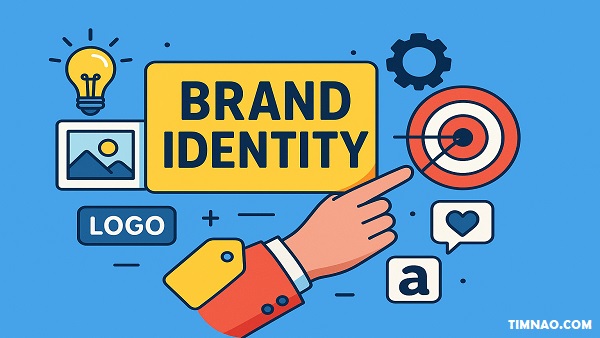Unstoppable Brand Success 🚀: Proven Strategies to Build a Strong Identity That Wins Hearts
Brand identity strategies are more than just logos and colors — they’re the foundation of how customers see, feel, and remember your business. Whether you’re starting from scratch or looking to refresh your image, mastering the art of branding is essential for standing out in today’s crowded marketplace. The right approach can transform a simple product or service into a trusted name that customers return to time and again.
In this comprehensive guide, we’ll explore proven methods for building a strong brand that resonates with your audience, sparks emotional connections, and drives long-term loyalty. You’ll discover practical tips, beginner-friendly tools, and real-world examples that make it easy to apply these concepts to your own business.
If you’ve ever wondered where to start with branding for beginners — from crafting a memorable logo to telling a brand story that inspires — you’re in the right place. This isn’t theory alone; it’s a hands-on roadmap you can put into action right away.
Table of Contents
- 🌟 Why Brand Identity Can Make or Break Your Business
- 🧩 The Core Elements Every Strong Brand Needs
- 📊 Using Market Research to Shape Your Brand
- 🎨 Designing a Visual Identity That Sticks
- 🎯 The Hidden Psychology of Colors in Branding
- 🖋️ Crafting a Logo That People Remember
- 💬 Finding the Perfect Brand Name
- 🗣️ Defining Your Voice and Tone for Consistency
- 📖 Brand Storytelling That Builds Emotional Connections
- 🚀 Launching Your Brand the Right Way
- 🌐 Managing Your Online Reputation Like a Pro
- 📱 Digital Branding and Social Media Growth
- ❤️ Customer Experience That Turns Buyers into Fans
- 🌍 Expanding Your Brand Internationally
- ♻️ Sustainability and Social Responsibility
- 🤖 Leveraging Technology to Strengthen Your Brand
- 📏 Measuring Brand Performance
- 🔄 When and How to Rebrand Without Losing Customers
- 🛠️ Overcoming Common Branding Challenges
- 📚 Upskilling: Training and Development for Brand Builders
🌟 Why Brand Identity Can Make or Break Your Business
If you’re starting out in branding for beginners, it’s easy to assume your brand is just a logo and some colors. In reality, brand identity strategies go far beyond visuals — they shape how people feel about your business before they even make a purchase. A strong brand identity builds trust, attracts the right customers, and keeps them coming back. A weak or inconsistent identity, on the other hand, can confuse your audience and make it difficult to compete.
Think about companies like Apple or Coca-Cola. Even without seeing the logo, you’d likely recognize their ads, tone of voice, and packaging. That’s because they’ve mastered the art of building a strong brand through consistent, intentional design and messaging.
The High Stakes of Brand Identity
Your brand identity acts like your business’s personality. It tells customers:
- Who you are.
- What you stand for.
- Why they should choose you over others.
Get it right, and you become memorable. Get it wrong, and you risk being forgotten — or worse, misunderstood.
A strong brand identity:
- Builds trust – Customers are more likely to buy from brands they feel they know.
- Differentiates you – In crowded markets, identity is often your biggest competitive edge.
- Boosts loyalty – People stick with brands they feel emotionally connected to.
The Common Pitfall: Inconsistency
One of the biggest mistakes in branding for beginners is inconsistency. Using different colors, changing tone from platform to platform, or updating your logo every year makes it hard for customers to recognize and trust you.
Consistency doesn’t mean you never evolve — it means changes are planned and aligned with your brand’s core message.
Quick Self-Check: Is Your Brand Identity Working?
Ask yourself:
- Do people instantly understand what my brand offers?
- Do they feel a specific emotion when they see my branding?
- Would they recognize my business without seeing my logo?
If the answer to any of these is “no,” it’s time to refine your brand identity strategies.
🧩 The Core Elements Every Strong Brand Needs
Building a strong brand is like building a house — you need solid foundations. These core elements work together to create a clear, memorable presence in your market.
1. A Clear Brand Purpose and Vision
Your brand purpose answers why you exist beyond making money. Your vision shows where you’re headed. When these are clear, every marketing and design decision becomes easier.
Example: Tesla’s purpose is to accelerate the world’s transition to sustainable energy. This guides everything from their product design to their social media content.
Action step: Write a short sentence describing your purpose and vision. Keep it visible for your team and partners.
2. A Recognizable Visual Identity
This includes your logo, colors, typography, and design style. Visual identity is what most people notice first — but it only works if it reflects your brand’s personality.
Helpful tools:
- Canva – Beginner-friendly design platform.
- Coolors – Generate color palettes.
- Looka – AI-powered logo maker.
3. A Consistent Brand Voice
Your voice is how your brand “speaks” in writing and speech. Whether it’s friendly, authoritative, or inspirational, it should feel consistent across emails, ads, and social posts.
Pro Tip: Document your voice in a brand style guide so anyone creating content for you can match your tone.
4. A Defined Target Audience
Strong brands know exactly who they’re talking to. Defining your audience helps you create messages and products that truly resonate.
Tools for audience insights:
- Google Analytics – Understand website visitor demographics.
- SurveyMonkey – Gather feedback directly from your audience.
5. Emotional Connection
The most successful brand identity strategies tap into feelings, not just facts. Customers may forget details about your product, but they’ll remember how your brand made them feel.
Example: Dove’s “Real Beauty” campaign focuses on self-confidence and inclusivity, turning soap ads into emotional moments.
Building Your Brand: Step-by-Step Starter Plan
If you’re new to branding for beginners, here’s a simple roadmap:
- Define your brand purpose and values.
- Research your target audience deeply.
- Create a mood board with colors, fonts, and imagery that reflect your personality.
- Write a short brand story that explains your “why.”
- Design your logo and visual assets.
- Apply your brand consistently across all platforms.
📊 Using Market Research to Shape Your Brand
Even the best brand identity strategies can fail if they aren’t grounded in real-world insights. Market research is how you uncover what your audience truly wants, what competitors are offering, and where your brand can stand out.
For branding for beginners, this step can feel intimidating — but it doesn’t have to be complicated or expensive. With the right tools and approach, you can gather valuable data that will guide your decisions and make building a strong brand far more effective.
Why Market Research Matters
Without research, you’re guessing. And guessing is risky when you’re investing time, money, and energy into your brand.
Market research helps you:
- Understand your audience’s needs, desires, and pain points.
- Identify gaps in the market you can fill.
- Avoid costly mistakes by testing ideas before launch.
- Position your brand more effectively against competitors.
Example: A small coffee brand might discover through surveys that their local audience values sustainability over price — leading them to focus on eco-friendly packaging rather than racing to the bottom on cost.
Step 1: Define Your Research Goals
Before collecting any data, ask yourself:
- What do I need to know to move forward?
- Am I trying to understand my audience, competitors, or both?
- What will I do with this information?
Clear goals keep your research focused and efficient.
Step 2: Start with Audience Research
Knowing who you’re speaking to is essential for building a strong brand.
Free and affordable tools:
- Google Trends – See what topics are gaining attention.
- SurveyMonkey – Create and distribute surveys to potential customers.
- AnswerThePublic – Discover questions people are asking online about your topic.
- Meta Audience Insights – Learn about your audience’s demographics and interests.
Step 3: Study Your Competitors
Understanding your competitors is a cornerstone of effective brand identity strategies. It’s not about copying — it’s about identifying opportunities to differentiate.
Competitive analysis checklist:
- Visual identity – What colors, logos, and styles are they using?
- Tone of voice – How do they communicate with their audience?
- Strengths – What are they doing well that you can learn from?
- Weaknesses – Where are they failing to connect?
Tools to help:
- SEMrush – Track competitor keywords and ad strategies.
- SimilarWeb – See competitor traffic sources and audience data.
- BuzzSumo – Find their most shared content.
Step 4: Combine Data with Observation
Numbers tell part of the story — observation fills in the rest. Follow your competitors’ social channels, sign up for their email lists, and even make small purchases to experience their customer journey.
You might notice patterns that don’t appear in raw data, such as how quickly they respond to customer inquiries or the types of visuals they use most often.
Step 5: Turn Insights into Action
Once you have your research, look for ways to apply it:
- Position your brand in a way that highlights what makes you different.
- Adapt your messaging to speak directly to your audience’s values.
- Refine your visual style to stand out in your industry.
Remember, market research isn’t a one-time task — it’s an ongoing process that keeps your brand relevant.
🎨 Designing a Visual Identity That Sticks
Your visual identity is the “face” of your brand. It’s often the first thing people notice, and it plays a huge role in making a lasting impression. For branding for beginners, getting your visuals right can set you apart instantly.
Step 1: Define Your Visual Style
Before choosing colors or designing a logo, decide on the overall style you want to convey. Is your brand modern and minimal, playful and colorful, or classic and elegant?
Example: Dropbox shifted from a clean, corporate look to a more colorful, creative identity when they expanded their audience beyond business users.
Step 2: Choose a Color Palette
Colors affect mood and perception. Select a palette that aligns with your brand’s personality and audience preferences.
Helpful tools:
- Coolors – Generates professional color schemes.
- Adobe Color – Explore trending color palettes.
💡 Pro Tip: Limit yourself to 3–5 main colors to keep your branding consistent.
Step 3: Pick the Right Fonts
Fonts carry personality too — serif fonts can feel traditional and trustworthy, while sans-serif fonts often feel modern and approachable.
Font resources:
- Google Fonts – Free, high-quality fonts for web and print.
- FontPair – Helps you find matching font combinations.
Step 4: Create Your Logo
Your logo should be simple, versatile, and scalable. Avoid overly complex designs that won’t work in small sizes or black-and-white formats.
Logo creation tools:
- Looka – AI-powered logo maker.
- Canva Logo Maker – Beginner-friendly with templates.
Step 5: Apply Your Visuals Consistently
Once you’ve defined your visual identity, use it across every touchpoint — from your website and social media to packaging and emails. Consistency builds recognition and trust, which are central to building a strong brand.
🎯 The Hidden Psychology of Colors in Branding
Color isn’t just decoration — it’s a silent language that shapes perception, stirs emotions, and even influences buying decisions. If you’re building a strong brand, understanding the psychology of colors can give you a competitive edge. The right palette can make your brand feel trustworthy, exciting, luxurious, or approachable — often before a customer reads a single word.
Research shows that up to 90% of a person’s snap judgment about a product is based on color alone. This is why successful brand identity strategies take color choice seriously from day one.
Step 1: Learn What Each Color Communicates
While color meanings can vary by culture, here are some common associations in Western markets:
- Red – Energy, excitement, urgency (Coca-Cola, Netflix).
- Blue – Trust, stability, professionalism (IBM, Facebook).
- Green – Growth, health, eco-friendliness (Starbucks, Whole Foods).
- Yellow – Optimism, friendliness, creativity (McDonald’s, Snapchat).
- Black – Luxury, sophistication, power (Chanel, Nike).
- Purple – Creativity, wisdom, premium quality (Cadbury, Hallmark).
Step 2: Match Colors to Your Brand Personality
If your brand is playful and youth-oriented, a bright palette might fit. If you’re targeting corporate clients, cooler, muted tones may build more trust.
Example: Spotify uses vibrant green paired with dark backgrounds to stand out in a crowded entertainment space, signaling energy and modernity.
Step 3: Use Color to Guide Behavior
In branding for beginners, it’s easy to overlook how color placement can influence actions. For example, call-to-action buttons in contrasting colors tend to get more clicks because they stand out.
Pro Tip: Test different button colors using A/B testing tools like Optimizely or VWO to see which drives better engagement.
Step 4: Consider Accessibility
Your color choices should be inclusive. Use tools like Contrast Checker to ensure your text is easy to read for people with visual impairments. This isn’t just ethical — it can improve your SEO and user experience.
Step 5: Stay Consistent Across All Platforms
Once you’ve chosen your palette, document it in a brand style guide with exact color codes (HEX, RGB, CMYK). Consistent color usage builds recognition and strengthens your brand identity over time.
🖋️ Crafting a Logo That People Remember
Your logo is often the most recognizable element of your brand. It’s the visual shortcut people use to identify you in a sea of competitors. The best logos are simple, relevant, and timeless — and they play a crucial role in building a strong brand.
Step 1: Understand the Types of Logos
There are several main logo styles:
- Wordmark – The brand name in a unique typeface (Google, Coca-Cola).
- Lettermark – Initials or monogram (IBM, HP).
- Pictorial Mark – An icon or symbol (Apple, Twitter/X).
- Abstract Mark – A unique geometric form (Nike swoosh, Pepsi globe).
- Combination Mark – Text + icon (Lacoste, Adidas).
For branding for beginners, combination marks often work well because they build recognition with both words and visuals.
Step 2: Keep It Simple
A great logo should be recognizable at a glance. Overly detailed designs don’t scale well and can look messy on small screens.
Example: Nike’s swoosh works on everything from billboards to shoelace tips because of its simplicity.
Step 3: Make It Versatile
Your logo will appear on websites, packaging, merchandise, and social media. It needs to work in:
- Color and black & white.
- Small and large sizes.
- Digital and print formats.
Step 4: Design with Your Brand Story in Mind
The best logos subtly reflect your values or mission. Amazon’s logo has an arrow from A to Z, symbolizing variety and customer satisfaction (a smile).
Step 5: Use Professional Tools or Designers
If you’re on a budget, start with online tools:
- Looka – AI-powered, customizable logos.
- Canva Logo Maker – Beginner-friendly templates.
- Fiverr – Hire freelance designers for custom work.
For long-term growth, consider investing in a professional designer who can create a logo that aligns perfectly with your brand identity strategies.
Step 6: Protect Your Logo
Once you finalize your design, protect it legally. Trademark registration ensures no one else can use your logo in your market. You can start the process with USPTO (for the U.S.) or your country’s intellectual property office.
💬 Finding the Perfect Brand Name
When it comes to brand identity strategies, your brand name is one of the most important decisions you will ever make. For anyone interested in branding for beginners, the name is more than a label — it’s your business’s first handshake with the world. It shapes perceptions, influences memory, and becomes the anchor point for all marketing efforts. A strong name makes building a strong brand far easier, while a weak or confusing name can hold you back for years.
Think of timeless examples like Nike, Apple, and Airbnb. They are short, memorable, and perfectly aligned with their brand story. None of them happened by accident — each was the result of a deliberate branding process.
Step 1: Define Your Brand Personality
Before brainstorming, you need clarity on the personality your name should convey. If you want a playful, youthful image, you might choose something like Snapchat — quick, fun, and informal. If you aim for authority and trust, names like Goldman Sachs or Brooks Brothers deliver an entirely different message.
Action step: List three to five adjectives that describe your brand. Keep them in front of you during brainstorming — they will keep you aligned with your brand identity strategies.
Step 2: Brainstorm with Structure
In branding for beginners, brainstorming without a plan can lead to dozens of ideas that don’t fit your market. Use a combination of descriptive words, metaphors, and made-up terms. Test combinations until something feels unique yet relevant.
Tools to help generate ideas:
- Namify – Generates creative names and checks domain availability instantly.
- NameMesh – Combines keywords to create fresh, brandable ideas.
- Wordoid – Generates original, invented words that still sound natural.
- Thesaurus.com – Find synonyms and related concepts to spark new directions.
💡 Pro Tip: Keep your shortlist to names that are easy to spell, pronounce, and remember.
Step 3: Verify Availability
A name that feels perfect isn’t much use if it’s already taken. As part of building a strong brand, you need to secure a matching domain and social handles.
Steps to check availability:
- Domain search – Use Namecheap or GoDaddy.
- Social handle check – Try Namechk to see if your preferred name is free across platforms.
- Trademark search – Visit USPTO (for US) or your country’s registry to avoid legal issues.
Skipping this step can lead to expensive rebrands later — a common pitfall in branding for beginners.
Step 4: Test with Real People
Once you have a shortlist, create simple logo mock-ups or sample packaging. Show them to people in your target audience and ask:
- “What does this name make you think of?”
- “Is it easy to remember and spell?”
- “Would you trust a company with this name?”
Real-world feedback reveals issues you might not notice in the brainstorming stage — such as awkward pronunciation or unintended cultural meanings.
🗣️ Defining Your Voice and Tone for Consistency
After securing your name, the next step in brand identity strategies is creating a recognizable voice and tone. This is especially important in branding for beginners, because your brand’s “personality” can either attract or repel your audience. A consistent voice builds trust and recognition, while inconsistency creates confusion.
Step 1: Identify Your Core Style
Your voice is your brand’s personality in words. Your tone adjusts that voice depending on the context. For example:
- Friendly & Conversational – Works well for lifestyle brands (e.g., Innocent Drinks).
- Professional & Authoritative – Trusted by finance, healthcare, and legal services (e.g., PwC).
- Inspirational & Motivational – Common in sports and coaching brands (e.g., Nike).
Pick three voice keywords — such as “Helpful, Confident, Approachable” — to keep your communication style consistent across all platforms.
Step 2: Create a Brand Voice Guide
For building a strong brand, a documented voice guide ensures that everyone on your team communicates consistently.
Include:
- Tone keywords – Your brand’s main personality traits.
- Do’s and Don’ts – e.g., “Do use simple words” / “Don’t overuse industry jargon.”
- Example phrases – Show the difference between “cold” and “warm” language in real contexts.
Helpful tools to document your voice:
- Notion – Create a shared space for team access.
- Google Docs – Easy to update and share.
- Canva Docs – Allows for visual branding examples in the guide.
Step 3: Keep a Consistent Voice Across Channels
Whether you’re posting on Instagram or writing a press release, your audience should feel like they’re hearing from the same “person.” Your tone might shift slightly — casual on social media, more formal in a pitch deck — but the core voice remains the same.
Example adaptations:
- Instagram post: Playful – “Your Monday mood booster is here ☕.”
- Customer support email: Empathetic – “We’re here to help you get the most out of your product.”
- Investor pitch: Confident – “Our innovation will redefine industry standards.”
To keep your tone on track, use Grammarly for tone checks and Hemingway Editor for readability.
Step 4: Review and Adjust as You Grow
As markets change, your voice may need slight adjustments — especially if you shift audiences. Review your voice guide every 6–12 months to ensure it still matches your goals. This flexibility ensures you remain relevant without losing the essence that makes your brand unique.
📖 Brand Storytelling That Builds Emotional Connections
In today’s crowded marketplace, facts and features alone rarely win hearts. People remember stories far more than they remember bullet points. That’s why brand storytelling is one of the most powerful brand identity strategies you can master — it turns your business from just another option into a relatable, memorable choice.
Think about Patagonia. They don’t just sell outdoor gear; they tell stories about environmental activism, sustainability, and community. Their audience doesn’t just buy jackets — they buy into a mission they believe in.
Step 1: Find Your Core Narrative
Your brand story isn’t your full company history. It’s the core narrative that communicates why you exist, who you serve, and what makes you different.
A simple formula:
Why you started + The problem you solve + The values that guide you = Your brand story.
For example:
- Why you started – “I was frustrated with wasteful packaging in the beauty industry.”
- Problem you solve – “We create sustainable, refillable cosmetics.”
- Values – “Eco-friendly, affordable, transparent.”
Step 2: Make It Relatable
If you’re building a strong brand, your story should feel like a conversation, not a press release. Share the real struggles, the moments you almost gave up, or the inspiration that kept you going. People connect with vulnerability and authenticity far more than with polished corporate talk.
Step 3: Choose the Right Formats
Your story can live in many places:
- Website About Page – Include a mix of text, photos, and maybe a short video.
- Social Media – Share snippets in Instagram captions, TikTok videos, or LinkedIn posts.
- Product Descriptions – Weave elements of your story into how you present your products.
Tools to help bring your story to life:
- Canva – Create visual storytelling graphics.
- Animoto – Simple video creation for brand storytelling.
- Copy.ai – Drafts story variations you can refine.
Step 4: Invite Your Audience Into the Story
Great stories aren’t just about you — they make your audience feel like the hero. Position your brand as the guide that helps them reach their goal. If you sell running shoes, the customer’s “story” is about completing their first marathon, and your role is to help them get there.
💡 Pro Tip: Keep your story consistent across all channels so your audience always gets the same emotional impression, whether they find you on Instagram, your website, or an email newsletter.
🚀 Launching Your Brand the Right Way
After months (or even years) of preparation, launching your brand is your moment to make a splash. For branding for beginners, this step can be overwhelming, but a well-planned launch sets the stage for future growth.
Step 1: Build Pre-Launch Buzz
Start creating curiosity before you officially launch.
- Tease behind-the-scenes content on social media.
- Share sneak peeks of your logo, packaging, or products.
- Create a waitlist or pre-launch signup page using tools like Mailchimp or ConvertKit.
This gives you an audience ready to act the moment you go live.
Step 2: Craft a Clear Launch Message
Your launch isn’t just “We’re open for business!” — it’s a story about why you’re launching and why now. Emphasize your unique value, tie it to your brand story, and make the first impression unforgettable.
Step 3: Use Multi-Channel Promotion
Don’t rely on one platform. Spread your message through:
- Social Media – Instagram, TikTok, LinkedIn depending on your audience.
- Email Marketing – Send exclusive offers to early subscribers.
- Press Releases – Use services like PRWeb to reach media outlets.
- Collaborations – Partner with influencers or brands that share your values.
Step 4: Make It an Experience, Not Just a Sale
Even for small brands, you can make a launch memorable:
- Host a live stream or webinar introducing your brand.
- Offer limited-time bonuses or bundles for early buyers.
- Create a hashtag and encourage customers to share their first impressions.
Step 5: Measure and Adapt
After launch, track what worked and what didn’t. Use Google Analytics to see website traffic sources, and Meta Business Suite for social performance. This helps refine your next campaign and strengthen your brand identity strategies over time.
🌐 Managing Your Online Reputation Like a Pro
In today’s hyper-connected world, your brand’s online reputation can make or break your success. One negative review, a poorly timed tweet, or unanswered customer complaint can spread quickly and damage the trust you’ve worked hard to build. That’s why brand identity strategies must include proactive reputation management — it’s no longer optional, it’s essential.
Think of your online reputation as your brand’s credit score. The higher it is, the more opportunities you’ll attract. The lower it is, the harder it becomes to grow, even if your products or services are excellent.
Step 1: Monitor Your Brand Everywhere
You can’t fix what you don’t see. Make it a habit to track mentions of your brand name, products, and even key team members across the internet.
Tools to help:
- Google Alerts – Get email notifications when your brand is mentioned online.
- Mention – Monitor social media, blogs, and news sites in real time.
- Brand24 – Track mentions, sentiment, and reach in a single dashboard.
Step 2: Respond Quickly and Professionally
When customers post reviews — positive or negative — acknowledge them. Thank people for positive feedback, and address complaints with empathy and solutions.
Pro Tip: Never get defensive. Even if a review feels unfair, your public response shows future customers how you handle criticism.
Example: JetBlue Airways has built a strong reputation for replying to customer tweets within minutes, often resolving issues in real time.
Step 3: Encourage Positive Reviews
Happy customers are often quiet customers — so make it easy for them to share their experiences. Send follow-up emails with direct review links, or offer small incentives like discount codes for leaving feedback (while following review platform rules).
Review-building tools:
- Trustpilot – Widely recognized consumer review platform.
- Google Business Profile – Essential for local search visibility.
Step 4: Manage Crisis Situations with a Plan
Even strong brands face negative publicity at some point. Having a crisis communication plan ensures you respond quickly, consistently, and in alignment with your brand identity strategies.
Your plan should include:
- A designated spokesperson.
- Pre-approved response templates.
- A decision-making process for escalations.
Step 5: Build a Positive Content Trail
A strong online reputation isn’t just about damage control — it’s also about creating a steady stream of positive content. Publish blog posts, videos, and case studies that highlight your expertise and values. This not only boosts trust but also pushes any negative content lower in search results.
📱 Digital Branding and Social Media Growth
Social media is where brands and customers meet daily. For branding for beginners, it’s one of the most cost-effective ways to reach new audiences and strengthen relationships with existing ones. But it requires a strategy — posting randomly and hoping for results won’t cut it.
Step 1: Choose the Right Platforms
Not every social media platform is worth your time. Focus on where your target audience is most active.
- Instagram – Great for visual brands, lifestyle products, and younger audiences.
- LinkedIn – Best for B2B, professional services, and industry networking.
- TikTok – Ideal for short, creative videos targeting Gen Z and Millennials.
- Pinterest – Perfect for design, crafts, home, and fashion inspiration.
Step 2: Create a Consistent Visual Style
Your social media presence should reflect your brand’s visual identity — the same colors, fonts, and tone used everywhere else. This reinforces recognition and strengthens building a strong brand.
Tools to help:
Step 3: Plan and Schedule Content in Advance
A content calendar keeps your posting consistent and aligned with your marketing goals.
Useful tools:
- Buffer – Schedule posts for multiple platforms.
- Hootsuite – Manage engagement and publishing in one place.
Step 4: Engage, Don’t Just Broadcast
Social media is a two-way conversation. Reply to comments, join discussions, and interact with other accounts in your industry. The more you engage, the more your audience feels valued.
Example: Wendy’s Twitter account became famous for witty replies and playful banter, turning everyday interactions into viral moments.
Step 5: Track, Learn, and Adjust
Use analytics to measure what’s working and what’s not. Focus on metrics that align with your goals — whether that’s reach, engagement, leads, or sales.
Analytics tools:
- Meta Insights – For Facebook and Instagram.
- TikTok Analytics – For understanding video performance.
❤️ Customer Experience That Turns Buyers into Fans
A great product may win you a sale, but a great experience wins you loyalty. In fact, customer experience (CX) is now one of the most important factors in building a strong brand. Studies show that 86% of buyers are willing to pay more for a better experience — meaning CX is not just “nice to have,” it’s a competitive advantage.
When your brand delivers consistently positive experiences, buyers evolve into fans who recommend you to others, leave glowing reviews, and come back for more. That’s why strong brand identity strategies extend far beyond logos and visuals — they shape every interaction a customer has with you.
Step 1: Map the Customer Journey
Start by identifying every touchpoint between your brand and your customer — from their first ad impression to post-purchase follow-ups.
Example touchpoints:
- Social media ads or organic posts.
- Your website or landing page.
- Checkout process.
- Delivery or service experience.
- Customer support interactions.
Tool to help:
- Miro – Create visual customer journey maps.
- Lucidchart – Diagram your customer touchpoints and workflows.
Step 2: Personalize Every Interaction
In the age of automation, personalization is what makes customers feel valued. Even branding for beginners can implement small personalization tactics, such as using customer names in emails or offering product recommendations based on purchase history.
Tools for personalization:
- Klaviyo – Advanced email marketing segmentation.
- HubSpot CRM – Track interactions and automate personalized follow-ups.
Step 3: Speed and Convenience Win
Your customers’ time is valuable. Whether it’s quick shipping, fast website loading times, or instant customer support, speed matters.
Example: Amazon’s “One-Click” checkout and Prime delivery are massive drivers of loyalty because they save time and reduce friction.
Tool to check site speed:
- Google PageSpeed Insights – Test and improve your website’s loading time.
Step 4: Make Support Easy and Accessible
Excellent customer support transforms problems into trust-building opportunities.
- Offer multiple support channels (email, live chat, social media).
- Maintain a clear FAQ or knowledge base for quick answers.
Tools for support:
- Zendesk – Omnichannel customer service platform.
- Tidio – Live chat and chatbot solutions for websites.
Step 5: Follow Up and Show Appreciation
After a purchase, check in with your customers. Ask if they’re satisfied, thank them for choosing your brand, or offer a small bonus for their next purchase. This makes them feel valued and deepens loyalty.
Example: Apple follows up service appointments with quick surveys, reinforcing their commitment to quality.
💡 Pro Tip: Consistency is key. A single bad experience can undo years of trust, so make sure your brand promise matches your delivery at every stage.
🌍 Expanding Your Brand Internationally
Once your brand is established locally, the next big growth opportunity could be going global. But international expansion is more than just translating your website — it’s adapting your brand identity strategies to new cultures, regulations, and markets.
Step 1: Research Target Markets Thoroughly
Before entering a new market, understand:
- Demand for your product or service.
- Cultural differences that could impact your branding.
- Legal and tax requirements.
Tools to help:
- Statista – Market and industry data worldwide.
- Export.gov – U.S. government resources for exporters.
Step 2: Adapt, Don’t Just Translate
What works in one country may fall flat in another. Logos, colors, and slogans can have different meanings across cultures.
Example: Pepsi’s “Come Alive” slogan famously translated in Chinese as “Bring Your Ancestors Back from the Dead,” causing confusion.
Tools for localization:
- Smartling – Translation and localization platform.
- Lokalise – Manage multilingual content efficiently.
Step 3: Build Local Partnerships
Local distributors, influencers, or co-branding opportunities can help you establish credibility in a new market faster. These partners can also help navigate cultural norms and customer preferences.
Step 4: Comply with Local Regulations
From packaging requirements to digital privacy laws, compliance is critical.
- The EU’s GDPR governs customer data.
- Many countries have rules for advertising and labeling.
Tool: Termly – Helps generate legal policies that meet international standards.
Step 5: Start Small and Scale
Test your product in one city or region before a full rollout. This allows you to adjust your approach without risking your entire budget.
Example: Starbucks entered China slowly, opening select stores to test menu items and service styles before expanding nationally.
♻️ Sustainability and Social Responsibility
Today’s consumers care about more than just products — they want to know the companies they buy from are making a positive impact. Sustainability and social responsibility are no longer “bonus points”; they’re often a deciding factor in purchasing decisions. Brands that ignore this trend risk being seen as outdated or uncaring, while those that embrace it can strengthen loyalty and stand out.
Integrating ethical practices into your brand identity strategies not only benefits the planet and society, but also reinforces trust and credibility.
Step 1: Define Your Commitments
Be specific about the causes you support. “We care about the environment” is vague — but “We use 100% recycled packaging and offset all shipping emissions” is concrete and credible.
Example: Patagonia openly shares its environmental impact reports and actively campaigns for climate action, making sustainability central to its identity.
Step 2: Align Actions with Brand Values
Your sustainability efforts should feel like a natural extension of your brand, not a marketing gimmick. If you’re in fashion, focus on ethical sourcing; if you’re in tech, look at reducing energy consumption or e-waste.
Pro Tip: Customers quickly spot “greenwashing” — vague claims without proof. Be transparent and back up your statements with evidence.
Step 3: Communicate Your Efforts Clearly
Show customers what you’re doing through your website, packaging, and social media. Use visuals, statistics, and stories to make the impact tangible.
Tools to help:
- EcoCart – Lets customers offset their order’s carbon footprint at checkout.
- Good On You – Rates brands based on ethical and sustainable practices.
Step 4: Involve Your Customers
Give customers a way to participate. For example, a clothing brand might offer discounts for returning old items for recycling, or a food brand might donate a portion of sales to local farms.
Example: TOMS popularized the “One for One” model, donating a pair of shoes for every pair sold, turning customers into active contributors to their mission.
Step 5: Measure and Report Progress
Regularly publish updates on your sustainability goals. Transparency builds credibility and shows you’re committed long-term.
💡 Beginner Tip: Even if you’re just starting out, small steps like switching to eco-friendly packaging or partnering with a local charity can be part of building a strong brand with a positive image.
🤖 Leveraging Technology to Strengthen Your Brand
Technology isn’t just for operational efficiency — it’s a powerful driver of branding. From automation tools to AI-driven insights, technology can help you understand customers better, deliver personalized experiences, and scale your reach without losing authenticity.
For branding for beginners, adopting the right tools early can help you compete with much larger companies.
Step 1: Use Data to Understand Your Audience
Analytics reveal what customers like, when they engage, and how they behave online. This information lets you refine your brand identity strategies for maximum impact.
Tools to help:
- Google Analytics – Tracks website visitor behavior.
- Hotjar – Visual heatmaps to see where users click and scroll.
Step 2: Personalize the Customer Experience
Technology makes personalization scalable. Automated email campaigns, AI chatbots, and dynamic website content can all adapt to customer preferences in real time.
Example: Netflix uses algorithms to recommend shows based on viewing history, keeping users engaged and loyal.
Tools for personalization:
- ActiveCampaign – Customer experience automation.
- Intercom – Conversational support and targeted messaging.
Step 3: Strengthen Brand Visibility with Automation
Posting consistently on social media, responding to messages, and sending follow-ups is easier with automation tools.
Tools:
Step 4: Use AI for Content Creation and Branding Assets
AI-powered design and writing tools can speed up creative processes without replacing human judgment.
Examples:
- Canva – Design templates and brand kits.
- Copy.ai – AI-generated copy for ads and social media.
- Looka – AI logo creation.
Step 5: Protect Your Brand Online
Cybersecurity is an often-overlooked aspect of branding. A data breach can severely damage trust, no matter how strong your visual identity is.
Tools for protection:
- Cloudflare – Website security and performance.
- 1Password – Secure password management.
📏 Measuring Brand Performance
You can’t improve what you don’t measure. Whether you’re just starting out or already building a strong brand, tracking brand performance helps you understand what’s working, what’s not, and where to invest next. Without clear metrics, you’re essentially guessing — and that’s risky in a competitive market.
Brand performance measurement isn’t just about sales. It’s about how your audience perceives you, how loyal they are, and how effectively your brand identity strategies are resonating with your target market.
Step 1: Define Your KPIs (Key Performance Indicators)
Before you start tracking, decide what success looks like for your brand. Some common KPIs include:
- Brand awareness – How many people know about your brand.
- Engagement rate – How actively customers interact with your content.
- Customer loyalty – Repeat purchase rate or subscription renewals.
- Net Promoter Score (NPS) – How likely customers are to recommend you.
Tool to help: Klipfolio – Create custom dashboards to track KPIs in real time.
Step 2: Monitor Brand Awareness
Brand awareness is the foundation of growth. You can track it using:
- Social media reach and impressions.
- Search volume for your brand name.
- Website traffic from branded searches.
Tools:
- Google Trends – Track search interest over time.
- Semrush – Monitor brand keyword rankings and mentions.
Step 3: Measure Brand Sentiment
Numbers alone don’t tell the full story — you also need to know how people feel about your brand. Sentiment analysis helps identify if conversations about you are mostly positive, neutral, or negative.
Tools for sentiment analysis:
- Brandwatch – Advanced social listening and sentiment tracking.
- Mention – Real-time monitoring of online mentions.
Step 4: Evaluate Customer Loyalty
Loyal customers are worth far more than one-time buyers. Track repeat purchases, subscription renewals, and customer lifetime value (CLV).
Example: Starbucks uses its Rewards app not only to drive repeat visits but also to collect valuable data on customer behavior.
Step 5: Review ROI on Branding Efforts
Every branding campaign should be tied to measurable business outcomes. Whether it’s increased sales, better conversion rates, or improved retention, knowing your ROI ensures you’re investing wisely.
Tool: HubSpot Marketing Analytics – Tracks campaign performance across channels.
💡 Beginner Tip: Start with just 3–5 metrics you can consistently track. Overcomplicating early on makes it harder to take action.
🔄 When and How to Rebrand Without Losing Customers
Rebranding can breathe new life into a business — or, if done poorly, alienate your loyal audience. The key is to approach it strategically, ensuring your new identity feels like a natural evolution rather than an abrupt change.
Step 1: Know When It’s Time to Rebrand
Common signs include:
- Your visual identity looks outdated.
- Your business has expanded into new products or markets.
- Your audience has shifted, and your current branding no longer connects.
- You’ve had a major reputation shift and need a fresh start.
Example: Instagram began as “Burbn,” a location-based check-in app, before rebranding into the photo-sharing platform we know today.
Step 2: Keep Core Values Intact
Your brand’s visual style can evolve, but the heart of your message — your mission and values — should remain familiar. This continuity reassures customers that while you’re changing, you’re still the same brand they trust.
Step 3: Involve Your Audience
Sharing sneak peeks of your new logo, packaging, or website design can build anticipation and make customers feel part of the journey. This is particularly useful in branding for beginners, where personal connection can outweigh big-budget campaigns.
Tool: Typeform – Gather audience feedback on potential design directions.
Step 4: Roll Out Gradually
Instead of flipping a switch overnight, consider a phased rollout:
- Update your website first.
- Follow with social media visuals.
- Refresh packaging last.
This staged approach reduces confusion and gives loyal customers time to adjust.
Step 5: Communicate the “Why” Clearly
Don’t just present your new branding — explain it. Share the reasoning behind the changes, what they represent, and how they benefit your customers.
Example: Airbnb’s 2014 rebrand came with a detailed video explaining the new logo and mission, turning potential confusion into renewed enthusiasm.
Step 6: Monitor Rebrand Reception
Use social listening tools and customer surveys to gauge reactions, address concerns, and refine as needed.
Tools:
- SurveyMonkey – Quick customer surveys.
- Hootsuite Insights – Track sentiment post-launch.
🛠️ Overcoming Common Branding Challenges
Even the best brand identity strategies face obstacles. Markets change, competitors emerge, and customer expectations evolve. For branding for beginners, these hurdles can feel overwhelming — but with the right approach, they can become opportunities to grow stronger.
Challenge 1: Standing Out in a Crowded Market
The problem: Your industry is saturated with similar products or services.
The solution: Find your unique value proposition (UVP). Focus on what you do differently — whether that’s superior customer service, innovative features, or a distinctive brand personality.
Example: Dollar Shave Club broke into a crowded razor market with humor-filled videos and a subscription model, positioning themselves far from traditional brands.
Tool to help: Value Proposition Canvas – Helps map out customer needs and how you uniquely meet them.
Challenge 2: Inconsistent Brand Messaging
The problem: Your tone, visuals, or messaging differ across platforms, causing confusion.
The solution: Create a brand style guide to unify everything — from color codes to voice and tone.
Tool to help: Frontify – Centralize your brand guidelines and share them with your team or collaborators.
Challenge 3: Limited Budget
The problem: You don’t have the funds for a big branding campaign.
The solution: Focus on low-cost, high-impact strategies like social media storytelling, user-generated content, and collaborations with micro-influencers.
Example: Glossier grew from a blog into a beauty brand by encouraging customers to share their own product photos, creating authentic buzz without a massive ad spend.
Challenge 4: Adapting to Market Changes
The problem: Trends shift quickly, leaving your brand behind.
The solution: Monitor industry news, customer feedback, and competitor actions regularly. Be willing to pivot your branding approach while keeping core values intact.
Tools to help:
- Feedly – Track industry trends.
- Google Alerts – Get notified when your brand or industry is mentioned online.
💡 Beginner Tip: Challenges are part of building a strong brand — the brands that last are the ones that adapt while staying true to their essence.
📚 Upskilling: Training and Development for Brand Builders
Branding is not a one-time project — it’s a skill that requires continuous learning. Markets evolve, consumer behavior shifts, and new tools emerge. Investing in your own growth ensures your brand stays relevant and competitive.
Step 1: Learn the Fundamentals of Branding
If you’re new, start with foundational knowledge — understanding brand positioning, identity design, and storytelling.
Free learning resources:
- HubSpot Academy – Free courses on marketing and branding.
- Canva Design School – Visual branding tips and tutorials.
Step 2: Stay Updated on Industry Trends
Follow thought leaders, subscribe to branding newsletters, and join professional groups.
Examples:
- Brandingmag – Insights on brand strategy.
- LinkedIn groups like Brand Strategy & Design Professionals.
Step 3: Master the Tools of the Trade
Knowing how to use branding tools can give you a competitive edge:
- Canva – For quick, consistent visuals.
- Figma – For collaborative design work.
- Hootsuite – For managing and scheduling social media branding campaigns.
Step 4: Attend Workshops and Conferences
Live events give you access to expert insights and networking opportunities.
- Branding Conference events (global and online).
- Local marketing meetups through Meetup.com.
Step 5: Practice with Real Projects
Learning theory is important, but applying it builds mastery. Volunteer to help a local business refine their brand, start a passion project, or do mock rebrands of existing companies to sharpen your skills.
Example: Many successful brand strategists started by helping friends or small community businesses for free, building their portfolio in the process.
Step 6: Get Feedback and Refine
Use peer reviews, mentor advice, or customer surveys to improve your skills. Branding is an art and science — iteration is part of the process.
Disclaimer:
The information provided in this article is for educational and informational purposes only. While every effort has been made to ensure the accuracy and relevance of the content, branding strategies, tools, and examples mentioned here may not guarantee specific results for every business. Your brand’s success depends on multiple factors, including your unique market, audience, and execution. We encourage readers to conduct their own research, seek professional advice where necessary, and evaluate all tools or services before use. We are not affiliated with, sponsored by, or endorsed by any third-party brands or platforms linked in this article.









